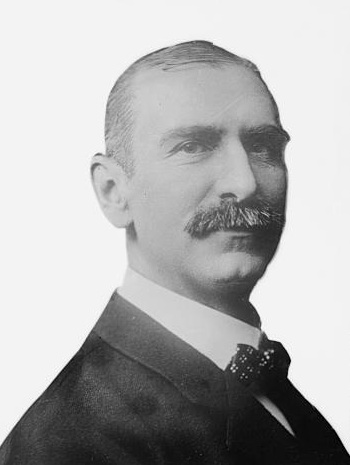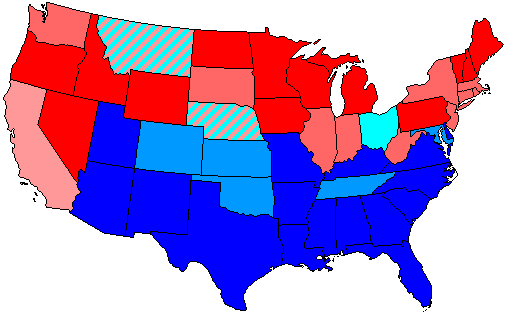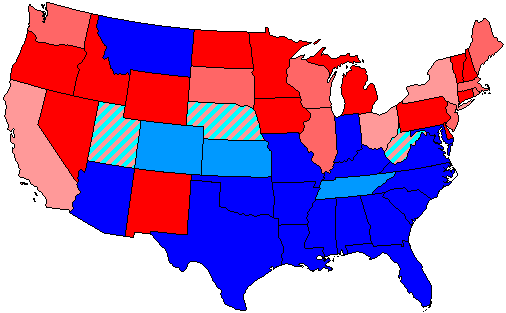|
New York's 38th Congressional District
New York's 38th congressional district was a congressional district for the United States House of Representatives in New York. It was created in 1913 as a result of the 1910 U.S. Census and eliminated in 1983 as a result of the redistricting cycle after the 1980 Census. It was last represented by Republican Jack Kemp who was redistricted into the 31st congressional district. Components 1973–1983: :Parts of Erie County 1971–1973: :All of Allegany County, Cattaraugus County, Chautauqua County and Steuben County :Parts of Erie County 1963–1971: :All of Allegany County, Cattaraugus County, Chautauqua County, Schuyler County and Steuben County 1953–1963: :All of Wayne County :Parts of Monroe County 1945–1953: :All of Cayuga County, Cortland County, Ontario County, Seneca County, Wayne County and Yates County 1913–1945: :Parts of Monroe County List of members representing the district Election results The following chart shows historic election resu ... [...More Info...] [...Related Items...] OR: [Wikipedia] [Google] [Baidu] |
New York State Route 38
New York State Route 38 (NY 38) is a north–south state highway in the Finger Lakes region of New York in the United States. Its southern terminus is at an intersection with NY 96 in the town of Owego in Tioga County. The northern terminus is at a junction with NY 104A in the town of Sterling in Cayuga County. NY 38 is a two-lane local road for most of its length. The route is the main access road to parts of Auburn, Dryden, Newark Valley and Port Byron. It passes through mountainous terrain in Tioga and Cortland counties, but the terrain levels out as it heads through the Finger Lakes area and Cayuga County. The route intersects several long-distance highways, including NY 13 in Dryden, U.S. Route 20 (US 20) and NY 5 in Auburn, and NY 31 in Port Byron. It passes over the New York State Thruway ( Interstate 90 or I-90) north of Port Byron; however, there is no connection between the two. NY 38 has two suffixe ... [...More Info...] [...Related Items...] OR: [Wikipedia] [Google] [Baidu] |
Cayuga County, New York
Cayuga County is a county in the U.S. state of New York. As of the 2020 census, the population was 76,248. Its county seat and largest city is Auburn. The county was named for the Cayuga people, one of the Indian tribes in the Iroquois Confederation. Cayuga County comprises the Auburn, NY Micropolitan Statistical Area, which is also included in the Syracuse-Auburn, NY Combined Statistical Area. History When counties were established in the Province of New York in 1683, the present Cayuga County was part of Albany County. This was an enormous county, including the northern part of the present state of New York and all of the present state of Vermont and, in theory, extending westward to the Pacific Ocean. This county was reduced in size on July 3, 1766, by the creation of Cumberland County, and further on March 16, 1770, by the creation of Gloucester County, both containing territory now in Vermont. On March 12, 1772, what was left of Albany County was split into three ... [...More Info...] [...Related Items...] OR: [Wikipedia] [Google] [Baidu] |
Democratic Party (United States)
The Democratic Party is one of the two major contemporary political parties in the United States. Founded in 1828, it was predominantly built by Martin Van Buren, who assembled a wide cadre of politicians in every state behind war hero Andrew Jackson, making it the world's oldest active political party.M. Philip Lucas, "Martin Van Buren as Party Leader and at Andrew Jackson's Right Hand." in ''A Companion to the Antebellum Presidents 1837–1861'' (2014): 107–129."The Democratic Party, founded in 1828, is the world's oldest political party" states Its main political rival has been the Republican Party since the 1850s. The party is a big tent, and though it is often described as liberal, it is less ideologically uniform than the Republican Party (with major individuals within it frequently holding widely different political views) due to the broader list of unique voting blocs that compose it. The historical predecessor of the Democratic Party is considered to be th ... [...More Info...] [...Related Items...] OR: [Wikipedia] [Google] [Baidu] |
Meyer Jacobstein
Meyer Jacobstein (January 25, 1880 – April 18, 1963) was a member of the United States House of Representatives from New York (state), New York. Early life According to family archives, Meyer was born on Henry Street on the Lower East Side of Manhattan to Polish Jews who had only weeks earlier immigrated to New York via Stockholm, Sweden. In 1881, the family moved to Syracuse, New York, and then relocated to Rochester, New York one year later. Coming from a family of tailors, he worked for less than a week in a Rochester tailor shop before deciding to attend high school instead. Academic career After attending public schools in Rochester, New York, he attended the University of Rochester and graduated from Columbia University in 1904. Jacobstein pursued postgraduate courses at the same university in economics and political science and became a special agent in the Bureau of Corporations and Department of Commerce in Washington, D.C., in 1907. Between 1909 and 1913, he work ... [...More Info...] [...Related Items...] OR: [Wikipedia] [Google] [Baidu] |
1920 United States House Of Representatives Elections In New York
The 1920 United States House of Representatives elections were held, coinciding with the election of President Warren G. Harding, the first time that women in all states were allowed to vote in federal elections after the passage of the 19th Amendment. The incumbent Democratic administration of Woodrow Wilson lost popularity after the conclusion of World War I in 1918, as American voters hoped to return to isolationism and avoid military conflict in the future. Heedless of the prevailing national mood, Wilson advocated American leadership in a new international order under the League of Nations, alienated voters of German and Irish ancestry, and constantly struggled with a Congress controlled by the opposition Republican Party. Harding and the Republicans promised a new start for the nation and a disassociation from Europe's political troubles that most voters found appealing. As a result, the Republicans picked up 63 seats in the House of Representatives, with most of the gai ... [...More Info...] [...Related Items...] OR: [Wikipedia] [Google] [Baidu] |
1918 United States House Of Representatives Elections In New York
The 1918 United States House of Representatives elections were held November 5, 1918, which occurred in the middle of President Woodrow Wilson's second term. With the country in World War I (contrary to previous promises by Wilson), and Wilson's personal popularity ebbing, the Republicans gained 25 seats and took over control of the House from Wilson's Democrats. Internal divide among Democratic leadership over aspects related to payment of the war also decreased the unity of the party, which had been the organization's strength during the decade. The Progressive Party also disappeared, with its former members generally becoming Democrats. Minnesota's Farmer–Labor Party, a descendant of populism, also gained its very first seat. Frederick H. Gillett (R-Massachusetts) became Speaker, and previous speaker Champ Clark (D-Missouri) became Minority Leader. Background Woodrow Wilson was elected to the presidency in the 1912 presidential election and his victory in the 1916 ele ... [...More Info...] [...Related Items...] OR: [Wikipedia] [Google] [Baidu] |
1916 United States House Of Representatives Elections In New York
1916 United States House of Representatives elections were held, coinciding with the re-election of President Woodrow Wilson. Wilson eked out a narrow re-election, but his Democratic Party lost seats to the Republican Party. Wilson's hybrid approach, which injected a progressive element into Democratic policies, had proved to be dissatisfying to much of the nation. International affairs also became important in the traditionally non-interventionist United States, as voters attempted to determine which party would be best served to keep the nation from entering The Great War. Republicans won a plurality of seats in the 1916 election. However, when the 65th Congress convened in April 1917, the Democrats narrowly maintained control of the House, forming an alliance with third-party ( Progressive and Socialist) members. Not since the 34th Congress (1855–1857) had the party with the most seats not been part of the ruling government. This Congress is the last example to date of a t ... [...More Info...] [...Related Items...] OR: [Wikipedia] [Google] [Baidu] |
1914 United States House Of Representatives Elections In New York
1914 United States House of Representatives elections were held in the middle of President Woodrow Wilson's first term. The opposition Republican Party had recovered from the split they underwent during the 1912 presidential election, and the party gained more than 60 seats from the Democratic Party, though not enough to regain control of the body. The burgeoning economy greatly aided Republicans, who pushed for pro-business principles and took credit for the success that had been reached in the industrial sector. Many progressive Republicans rejoined the Republican Party, but six remained under the Progressive Party banner in the new Congress. In addition, William Kent was re-elected in as an independent, and two minor party candidates were elected: Charles H. Randall, a Prohibition Party member, in ; and Meyer London, a Socialist Party member, in . Election summaries Early election date Maine held its elections early, on September 14, 1914. There had previously bee ... [...More Info...] [...Related Items...] OR: [Wikipedia] [Google] [Baidu] |
1912 United States House Of Representatives Elections In New York
The 1912 United States House of Representatives elections were held, coinciding with the 1912 United States presidential election, election of President Woodrow Wilson. Wilson's victory was partly due to the division of the opposition Republican Party (United States), Republican Party into conservative and progressive factions. While many progressives stayed within the party framework, they maintained lukewarm relationships with Republican leadership. Others formed a third party (politics), third party known as the Progressive Party (United States, 1912), Progressives and several switched allegiance to the Democratic Party (United States), Democrats. A message of unity was portrayed by the Democrats, allowing this group to present themselves as above the bickering and corruption that had become associated with the Republican internal feud. Many of the new seats that were added after the prior census ended up in Democratic hands. In addition, William Kent (U.S. Congressman), Willia ... [...More Info...] [...Related Items...] OR: [Wikipedia] [Google] [Baidu] |
Republican Party (United States)
The Republican Party, also referred to as the GOP ("Grand Old Party"), is one of the two major contemporary political parties in the United States. The GOP was founded in 1854 by anti-slavery activists who opposed the Kansas–Nebraska Act, which allowed for the potential expansion of chattel slavery into the western territories. Since Ronald Reagan's presidency in the 1980s, conservatism has been the dominant ideology of the GOP. It has been the main political rival of the Democratic Party since the mid-1850s. The Republican Party's intellectual predecessor is considered to be Northern members of the Whig Party, with Republican presidents Abraham Lincoln, Rutherford B. Hayes, Chester A. Arthur, and Benjamin Harrison all being Whigs before switching to the party, from which they were elected. The collapse of the Whigs, which had previously been one of the two major parties in the country, strengthened the party's electoral success. Upon its founding, it supported c ... [...More Info...] [...Related Items...] OR: [Wikipedia] [Google] [Baidu] |
Thomas B
Thomas Browne Henry (November 7, 1907 – June 30, 1980) was an American character actor known for many guest appearances on television and in films. He was active with the Pasadena Community Playhouse and was the older brother of actor William Henry. Selected filmography * ''Hollow Triumph'' (1948) - Rocky Stansyck (uncredited) * '' Behind Locked Doors'' (1948) - Dr. Clifford Porter * ''Sealed Verdict'' (1948) - Briefing JAG colonel * ''Joan of Arc'' (1948) - Captain Raoul de Gaucort * ''He Walked by Night'' (1948) - Dunning (uncredited) * ''Impact'' (1949) - Walter's Business Assistant (uncredited) * ''Tulsa'' (1949) - Mr. Winslow (uncredited) * ''Johnny Allegro'' (1949) - Frank (uncredited) * ''House of Strangers'' (1949) - Judge (uncredited) * '' Special Agent'' (1949) - Detective Benton (uncredited) * '' Flaming Fury'' (1949) - Robert J. McManus (uncredited) * '' Post Office Investigator'' (1949) - Lt. Contreras * '' Bagdad'' (1949) - Elder (uncredited) * '' Underto ... [...More Info...] [...Related Items...] OR: [Wikipedia] [Google] [Baidu] |
Yates County, New York
Yates County is a county in the U.S. state of New York. As of the 2020 Census, the population was 24,774, making it the third-least populous county in New York. The county seat is Penn Yan. The name is in honor of Joseph C. Yates, who as Governor of New York signed the act establishing the county. Yates County is included in the Rochester, NY Metropolitan Statistical Area. History When counties were established in New York State in 1683, the present Yates County was part of Albany County. This was an enormous county, including the northern part of New York State as well as all of the present State of Vermont and, in theory, extending westward to the Pacific Ocean. This county was reduced in size on July 3, 1766, by the creation of Cumberland County, and again on March 16, 1770, by the creation of Gloucester County, both containing territory now in Vermont. On March 12, 1772, what was left of Albany County was split into three parts, one remaining under the name Albany Count ... [...More Info...] [...Related Items...] OR: [Wikipedia] [Google] [Baidu] |





